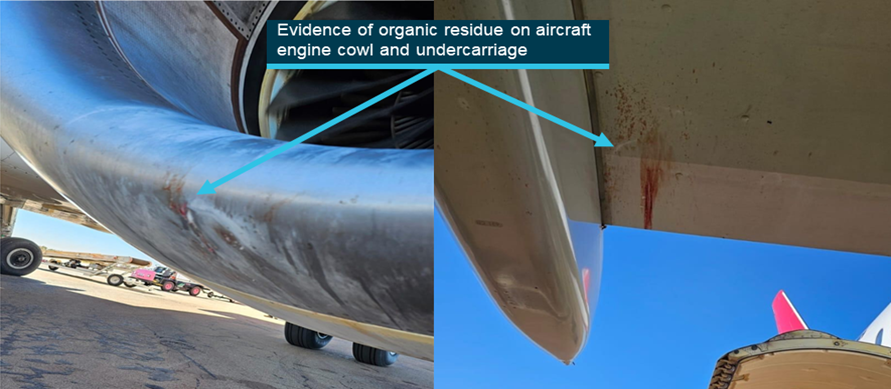What happened
At about 0920 local time, an Airbus A320-232 was departing from Newman Airport, Western Australia carrying 93 passengers and 6 crew on a scheduled passenger transport flight to Perth. During take-off, as the aircraft reached rotation speed,[1] the flight crew observed a large flock of galahs at the lower edge of the windshield and subsequently heard multiple impacts on the airframe. The crew observed a pitch change to the engine sound and identified increased vibration on the number 1 engine compared to engine number 2. No alert was presented on the electronic centralised aircraft monitor (ECAM) and the crew continued to climb to 6,000 ft. They then performed the after take‑off checks and noticed a reduction in the high-pitched noise and engine vibration when the reduction to climb thrust was selected. When the aircraft levelled at 6,000 ft the pitch returned to normal.
After discussion and suspecting engine damage from the birdstrike, the crew decided to return to Newman Airport as a precaution. Notification of the intended change in plan was communicated to the passengers, the operator and air traffic control (ATC). The crew conducted a briefing and acknowledged that if the ECAM system displayed any alerts during the approach they would ensure that all actions were completed by 1,000 ft. After discussion with ATC, a decision was made not to declare a PAN or request additional services and the aircraft landed safely.
Figure 1: Photographs of aircraft with evidence of a birdstrike

Source: Operator
A post-flight inspection of the aircraft found evidence of multiple strikes to the engine cowl and flap (Figure 1) but no damage to the airframe. The operator’s engineer identified that numerous birds had been ingested into both engines and had visibly caused minor damage resulting in the need for a more detailed inspection.
Safety message
Occurrences involving aircraft striking wildlife, particularly birds, continue to be the most common aviation occurrence reported to the ATSB. Birdstrikes are a potential safety risk to aircraft and aerodrome operators.
The ATSB has recently launched a new dedicated aviation wildlife strike occurrence dashboard, which aims to provide valuable information to pilots, aerodrome and aircraft operators, aviation regulators and other industry participants, to assist with understanding and managing the hazards associated with wildlife strikes. Importantly, the dashboard does not include any identifying information about pilots or aircraft.
Birdstrikes typically result in nil to minor damage to aircraft, and nil to minor injuries to occupants, however, severe and fatal accidents as a result of birdstrikes in small aircraft have occurred. Birdstrikes can occur during any phase of flight but are more common during the take-off and landing phases, due partly to the increased numbers of birds at lower heights. Aerodrome operators employ various measures to mitigate these occurrences and to control bird numbers. However, when a birdstrike does happen, pilots are ultimately required to deal with the consequences. By following established procedures and prioritising effective communication, the outcomes associated with birdstrikes can be mitigated by pilots.
About this report
Decisions regarding whether to conduct an investigation, and the scope of an investigation, are based on many factors, including the level of safety benefit likely to be obtained from an investigation. For this occurrence, no investigation has been conducted and the ATSB did not verify the accuracy of the information. A brief description has been written using information supplied in the notification and any follow-up information in order to produce a short summary report and allow for greater industry awareness of potential safety issues and possible safety actions.
[1] Rotation speed: the speed at which the rotation of the aircraft is initiated to take-off attitude.


